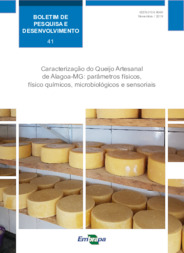Evaluation of risk factors for specific pathogens and ripening time in Brazilian artisanal cheeses to ensure safety
Evaluation of risk factors for specific pathogens and ripening time in Brazilian artisanal cheeses to ensure safety
Artisanal cheeses are traditionally produced from raw milk. In the State of Minas Gerais they are regarded as intangible heritage of humanity by the Institute of National Historical and Artistic Heritage, with the following two regions of the State being awarded a geographic indication label: Canastra and Serro. These indications have been pursued by other regions producing artisanal cheeses. Currently, their sale is permitted by official bodies, but their production safely to the consumer is still a challenge to the Ministry of Agriculture, Livestock and Food Supply (MAPA), which does not have answers on: i) the most prevalent pathogens in artisan cheeses and risk factors for their presence in this class of food, ii) the spatial distribution of such pathogens, iii) the ideal maturation time to make artisan cheese harmless to consumers and iv) the main critical control points to be focused by programs of good agricultural practices (GAP) and good manufacturing practices (GMP) for the production of a safe artisanal cheese. This project aims to determine the most prevalent pathogens, to evaluate the factors associated with them and analyze whether the maturation has the potential to eliminate them. The study covers the following artisanal cheeses: i) Serro and Canastra (from municipalities of Minas Gerais State); ii) Coalho (from the municipalities of Parnaíba and Currais Novos - Rio Grande do Norte State, Fortaleza - Ceará State, and Garanhuns - Pernambuco State); iii) Nicola (from the municipality of Corumbá - Mato Grosso do Sul State); iv) Marajó Island (Pará State); v) Serrano (mountain regions of Rio Grande do Sul State and Santa Catarina State); and vi) Colonial (Pelotas – Rio Grande do Sul State). The study selected 384 artisanal cheesemakers from those regions, using random selection in records of defense or extension agencies. Those cheesemakers are individually interviewed and provide cheese samples for the analysis. Collected cheese samples will undergo physical and chemical analysis and the same microbiological analysis routinely carried out in milk, namely: coliforms, mesophylls and Escherichia coli, Staphylococcus aureus (and its toxins), Salmonella, Listeria monocytogenes, Streptococcus equi subsp. zooepidemicus, Mycobacterium bovis, Brucella spp. and Mycobacterium avium subsp. paratuberculosis, Campylobacter jejuni and Coxiella burnetii. Cheeses will also undergo molecular analysis for detection of non-cultivable microorganisms. This is the most comprehensive study ever conducted in Brazil, either in spatial extent, in number of microorganisms studied, as well as in the broad range of sampled artisanal cheeses, and to fulfill this purpose and achieve the proposed objectives, the project assembled an extensive network of research teams from various units of Embrapa (i.e. Embrapa Beef Cattle, Embrapa Dairy Cattle, Embrapa Mid-North, Embrapa Pantanal, Embrapa Temperate Agriculture and Embrapa Tropical Agroindustry) research institutes (Adolfo Lutz Institute, Cândido Tostes Dairy Institute, Oswaldo Cruz Foundation and Pernambuco technology Institute) and defense agencies (MAPA and State bodies). The following results are expected: 1) construction of explanatory models for the presence of pathogens in artisanal cheeses (risk factors) and for the effect of aging time on the survival of pathogens; 2) knowledge of the most prevalent pathogens; 3) the knowledge of pathogen prevalence, risk factors and optimal ripening time will support MAPA and state protection agencies in decision making on standards, regulation of new laws or public policy formulation and creation of rules; and 4) the knowledge generated by the project can be applied to GAP and GMP manuals and courses for training multipliers and extension workers, in order to make artisanal cheese safer for consumers, thereby contributing to their dissemination among consumers.
Status: Completed Start date: Tue Jan 01 00:00:00 GMT-03:00 2019 Conclusion date: Thu Sep 28 00:00:00 GMT-03:00 2023
Head Unit: Embrapa Dairy Cattle
Project leader: Marcio Roberto Silva
Contact: marcio-roberto.silva@embrapa.br

